Search the Blog
Categories
- Books & Reading
- Broadband Buzz
- Census
- Education & Training
- General
- Grants
- Information Resources
- Library Management
- Nebraska Center for the Book
- Nebraska Memories
- Now hiring @ your library
- Preservation
- Pretty Sweet Tech
- Programming
- Public Library Boards of Trustees
- Public Relations
- Talking Book & Braille Service (TBBS)
- Technology
- Uncategorized
- What's Up Doc / Govdocs
- Youth Services
Archives
Subscribe
Author Archives: Sam Shaw
Friday Reads: League of Denial
 Let me say up front (gasp!) that I am not a football fan. Not one bit. OK, I admit that at a time in my life long ago I might become moderately interested in seeing a good game (and rooting for the underdogs), but in today’s day and age I have little interest. I read the bulk of League of Denial by Mark Fainaru-Wada and Steve Fainaru while hanging out in airports and on airplanes during a recent trip. Before getting into the content of League of Denial, it might be beneficial to describe the authors’ backgrounds, as well as why these brothers have different last names (including the origin of the hyphen). Steve Fainaru is an award winning reporter for the Washington Post (known for his field reporting in Iraq). His brother Mark (he hyphenated his name with that of his wife’s) has a background in sports reporting for the San Francisco Chronicle, worked on the BALCO steroids reporting (subsequently co-authoring Game of Shadows), and is a current investigative reporter for ESPN.
Let me say up front (gasp!) that I am not a football fan. Not one bit. OK, I admit that at a time in my life long ago I might become moderately interested in seeing a good game (and rooting for the underdogs), but in today’s day and age I have little interest. I read the bulk of League of Denial by Mark Fainaru-Wada and Steve Fainaru while hanging out in airports and on airplanes during a recent trip. Before getting into the content of League of Denial, it might be beneficial to describe the authors’ backgrounds, as well as why these brothers have different last names (including the origin of the hyphen). Steve Fainaru is an award winning reporter for the Washington Post (known for his field reporting in Iraq). His brother Mark (he hyphenated his name with that of his wife’s) has a background in sports reporting for the San Francisco Chronicle, worked on the BALCO steroids reporting (subsequently co-authoring Game of Shadows), and is a current investigative reporter for ESPN.
League of Denial details the NFL’s concussion crisis. It describes the first players that were diagnosed (post-mortem) with chronic traumatic encephalopathy (CTE), a progressive degenerative disease that had previously only been identified in boxers or other persons that suffered repeated blows to the head. League of Denial chronicles a number of former NFL players who suffered from the effects of CTE, from their playing days to their life struggles after retirement. The first former player to be diagnosed with CTE was Pittsburgh Steeler hall of fame center Mike Webster. Webster’s story is interesting because his life is illustrative of the struggle that many former players go through during and after their days in the NFL. It’s a very sad story. League of Denial chronicles Webster’s retirement financial troubles, living out of his truck, addiction to various prescription medications, and the fact that he often couldn’t sleep unless a friend hit him with a Taser, rendering him incapacitated for brief periods of time. To illustrate, this interview, taken from the PBS Frontline documentary (titled League of Denial) shows the depth of his brain injury, as well as the struggle of former NFL safety Gene Atkins.
Then there are the suicides. A number of these former players that committed suicide were diagnosed with CTE afterward. League of Denial describes some of these, including Terry Long (45 years old, drank antifreeze), Dave Duerson (50 years old, shot himself in the chest and left a note indicating that he wanted his brain to be used for research), and Junior Seau (43 years old, another gunshot to the chest). League of Denial has a bit of it all, including intrigue, mystery, and cover-ups. A land where NFL doctors argue with independent ones, former players fight for disability payments, and the NFL (by far the leader in worldwide sports revenues fights to maintain its image (among fans, players, and moms). A lot of parallels exist between the NFL concussion crisis and the tobacco industry, and many of the league insiders have called for a different handling of the crisis by the NFL, which up until recently denied any link between football’s inherent traumas to the head and CTE. Dr. Ann McKee, longtime Packers fan and professor of Neurology & Pathology at Boston University, aptly sums things up by saying:
“Football is an American sport. Everyone loves it. I certainly would never want to ban football. . . . We haven’t banned cigarette smoking. People smoke. People make that choice. But they need to make an informed decision. They need to understand the risks and it needs to be out there if they want to pay attention to what those risks are.”
I would recommend this book, even though Ann is wrong about everyone loving football. It is an easy read and informative, whether you are a fan or not a fan, and the science surrounding the concussion crisis is presented in an interesting way.
The Public Library Survey is now available on Bibliostat
 The annual IMLS public library survey (submitted via Bibliostat) is now available. The survey deadline is February 17, 2017. Completion of the survey is required for your library to receive state aid if you are accredited. If you aren’t accredited, you still have an incentive to complete the survey ($200), called Dollar$ for Data.
The annual IMLS public library survey (submitted via Bibliostat) is now available. The survey deadline is February 17, 2017. Completion of the survey is required for your library to receive state aid if you are accredited. If you aren’t accredited, you still have an incentive to complete the survey ($200), called Dollar$ for Data.
Please feel free to contact me if you have any questions throughout the process. You can always start the survey, save your submissions, and then resume at a later date. It doesn’t have to all be done at once. Tip: It’s always a good idea to click on the red “save” button in Bibliostat before clicking “next” to the next screen. Thank you in advance for your participation.
Posted in General, Library Management, Uncategorized
Leave a comment
Friday Reads: Altamont
 It would be a gross understatement to say that Joel Selvin’s Altamont provides a mere description of the events leading up to and during the Altamont music festival (December 6, 1969). The San Francisco music critic provides much deeper coverage, including the overall music culture at the time, the Woodstock festival, the Rolling Stones, the Grateful Dead, and the lives of musicians and managers that were involved in these and other music events in the late 1960’s. And the other major player at Altamont, the Hells Angels.
It would be a gross understatement to say that Joel Selvin’s Altamont provides a mere description of the events leading up to and during the Altamont music festival (December 6, 1969). The San Francisco music critic provides much deeper coverage, including the overall music culture at the time, the Woodstock festival, the Rolling Stones, the Grateful Dead, and the lives of musicians and managers that were involved in these and other music events in the late 1960’s. And the other major player at Altamont, the Hells Angels.
The organizers of the Altamont festival, which was plugged as “Woodstock West”, unfortunately learned very few of the lessons that came from Woodstock. Altamont was largely a project put together by the Rolling Stones and other assorted handlers that included the Grateful Dead, and was in the end a semi-functional disaster. The Rolling Stones hadn’t toured since 1966, partly due to travel restrictions because of drug charges, and were in a financial crisis so to speak. So in November of 1969 the Stones began touring the U.S., playing large sold-out arenas with ticket prices outside of the norm (and also subsequently skipping from town to town without paying their hotel and travel bills). Altamont was supposed to be the answer to media and fan criticism of the Stones’ high ticket prices, but there were a few other factors at play in their decision to engage in a large scale concert. For one, the Stones weren’t at Woodstock, so there was perhaps an effort for something similar to make their mark (think grand scale). Secondly, the concert, although free to those attending, was always about the money. Perhaps not for a band like the Grateful Dead, but definitely for the Stones. For instance, Selvin describes one of the contributors to the chaos of the event being the multiple changes of venue. At one point, the Sears Point Raceway (now Sonoma Raceway) was selected and theoretically would have been a much better choice for the event than Altamont (after the organizers failed to obtain a permit to hold the event at Golden Gate Park). However, the Sears Point owners requested cash up front and film distribution rights, and the Stones weren’t willing to give that up. In the long run, it would have been well worth it.
In addition to the Stones, the lineup for the Altamont concert included Santana, Jefferson Airplane, The Flying Burrito Brothers, Crosby, Stills, Nash & Young, and the Grateful Dead (although due to increased violence throughout the day of the event, the Dead decided not to play). With the last minute change in venue, one of the problems with the event was the fact that the stage could not be properly erected (and therefore lacked a natural barrier between the musicians and the mixture of LSD, amphetamines, and cheap wine that laced the crowd). The stage stood less than four feet high (compared with 15 feet at Woodstock). Added to the logistical difficulties were huge amount of traffic, inadequate roads, and the lack of other essentials such as food, water, and facilities (yes, those kinds of facilities). Finally (and perhaps most importantly), due to a distrust of the cops, at the suggestion of Jefferson Airplane, the Stones hired no security for the event other than paying the Hells Angels $500 worth of beer (on a truck with ice) in exchange for the Angels agreement to hang out in front and keep the spectators off the stage. And as we all know, the Hells Angels ain’t no cops (especially when they are spending the entire day and night drinking free ice cold beer). The scene at Altamont reeked of trouble from the start, as Selvin offers this depiction of Santana (the first band of the day) beginning to play:
“Santana drummer Michael Shrieve sensed the fog of evil as soon as he settled behind his kit and looked around. The stage felt claustrophobic and the audience packed up against it as tightly as they could. He saw one particularly menacing Hells Angel called Animal, who was wearing a coyote skin as a headdress—the flattened, dried-out head of the long-dead animal hanging grotesquely over his forehead. Something felt wrong from the start. … The Angels waded into the crowd flailing pool cues another half dozen times during the band’s forth-five-minute set, chasing down a hippie photographer who refused to give up his film, smacking around some freaked-out kid trying to escape by climbing onto the stage.”
All said and done, the casualties at Altamont included four deaths, numerous beatings at the hands of the Angels, and general bad vibes. Selvin paints an intriguing and engaging portrait of the events leading up to and during Altamont, as well as the major players. If you have any interest in the historical events of the late 1960’s, the Rolling Stones, or the rock musicians from San Francisco scene during that time, this is an easy and interesting read.
Friday Reads: Disrupted
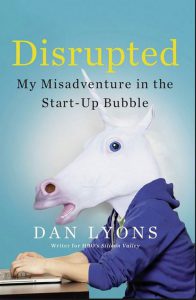 In Disrupted, Dan Lyons tells the story of his time working as a writer (mostly blogs) for the tech startup company HubSpot. Prior to working at HubSpot, Lyons had a number of writing gigs and most of them were technology related. His previous work included writing for Newsweek, New York Times Magazine, GQ, Vanity Fair, Wired, and writing the Secret Diary of Steve Jobs blog. When his position at Newsweek was eliminated, he found himself looking for work at the age of 50, while married with two kids to take care of (his wife had medical issues and was not working at the time). He started the search for new employment and eventually landed at HubSpot, a company that provides software for “inbound marketing.” Disrupted tells the story of Lyons searching for and then subsequently obtaining new employment (and the challenges that go with that) as an “older” adult (and with much younger colleagues), but also his general experience working within the unique tech environment. While not geographically Silicon Valley (HubSpot is located in Cambridge, Massachusetts) Lyons provides an apt description of an insider’s view from within a tech startup.
In Disrupted, Dan Lyons tells the story of his time working as a writer (mostly blogs) for the tech startup company HubSpot. Prior to working at HubSpot, Lyons had a number of writing gigs and most of them were technology related. His previous work included writing for Newsweek, New York Times Magazine, GQ, Vanity Fair, Wired, and writing the Secret Diary of Steve Jobs blog. When his position at Newsweek was eliminated, he found himself looking for work at the age of 50, while married with two kids to take care of (his wife had medical issues and was not working at the time). He started the search for new employment and eventually landed at HubSpot, a company that provides software for “inbound marketing.” Disrupted tells the story of Lyons searching for and then subsequently obtaining new employment (and the challenges that go with that) as an “older” adult (and with much younger colleagues), but also his general experience working within the unique tech environment. While not geographically Silicon Valley (HubSpot is located in Cambridge, Massachusetts) Lyons provides an apt description of an insider’s view from within a tech startup.
Lyons, albeit somewhat reluctantly, accepted the job at HubSpot for a few different reasons. For one, it was geographically close to home and his family. Secondly, he had a number of friends who reaped large financial benefits from working in tech startups (and had vouched that HubSpot was indeed legit), so there was a motivation of financial self interest. And thirdly, after writing about tech issues and companies for so long he was curious about experiencing the culture from an insider’s perspective. His experiences, as Disrupted details in often humorous and depressing fashion, were overall less than stellar. As he became immersed in the HubSpot culture, the realism of the organization he now was a part of settled in:
“This is the peppy, effervescent, relentlessly positive, incredibly hubristic and overconfident attitude that everyone in the HubSpot marketing department exudes from [the head] on down. These people are super cheery cheerleaders. The whole world of online sales and marketing is filled with people who listen to Tony Robbins audiobooks on their way to work and dream of unleashing the power within themselves, people who love schmaltzy, smarmy motivational-speaker guff about being passionate, following your dreams, and conquering fear.”
Lyons has now moved on from HubSpot, subsequently writing for HBO’s Silicon Valley (a gig he started while still at HubSpot). The thing that Lyons nails is his apt portrayal of the culture, including how these startups often don’t really make money, the lack of diversity (and apparent non-concern about it), sexism and ageism (Mark Zuckerberg once said that “Young people are just smarter”), and more concern with the fact that employees have bean bag chairs, ping pong tables, and unlimited supplies of beer, candy, and hype than actually producing a decent product that the average person understands. Lyons sums this up when mentioning the co-founders of Twitter (incidentally, Twitter hasn’t ever turned a profit), specifically Biz Stone, who has an estimated net worth of $200 million. Since leaving Twitter, Stone started two companies, Jelly and Super. As Lyons notes, no one understands what the companies actually do, including Stone himself:
“I know this is eye-rollingly, hallucinogenically optimistic…but our mission is to build software that fosters empathy.”
If you are interested in an insider’s view of tech startups, Disrupted is an easy and most entertaining read. If you liked HBO’s Silicon Valley, you would also like this book. And for the record, if you want to foster empathetic relationships, begin with your day to day interactions with real life human beings. Start with Hi. You don’t need software for that.
The Data Dude: 2015 FY Data Now Available
 Shaka. The 2015 public library survey data is now available on the NLC website. This is preliminary data (meaning that it has not yet been certified by IMLS) so keep in mind that it might be subject to change (but most likely it will not). There is also a data dashboard that summarizes the data. Thanks to all of you who submitted your statistics.
Shaka. The 2015 public library survey data is now available on the NLC website. This is preliminary data (meaning that it has not yet been certified by IMLS) so keep in mind that it might be subject to change (but most likely it will not). There is also a data dashboard that summarizes the data. Thanks to all of you who submitted your statistics.
The Data Dude on Public Library Survey Completion
 Shaka. Thanks again to all of you who submitted your public library survey via Bibliostat, and to those unaccredited libraries who submitted the survey on paper, answering the federally required questions. Our data has been submitted to IMLS, and as soon as some cleanup occurs, the full data set will be available on our website. Our response rate jumped a bit this year, up to 89%. For those of you who might be new to the survey, now would be the time to start collecting your statistics for next year’s reporting cycle, which begins mid-November. If you are a new director, take a look at our guide for new directors. If you are one of those unaccredited libraries who responded to the survey on paper, if those statistics are submitted online next cycle, you will be eligible for a Dollar$ for Data grant payment.
Shaka. Thanks again to all of you who submitted your public library survey via Bibliostat, and to those unaccredited libraries who submitted the survey on paper, answering the federally required questions. Our data has been submitted to IMLS, and as soon as some cleanup occurs, the full data set will be available on our website. Our response rate jumped a bit this year, up to 89%. For those of you who might be new to the survey, now would be the time to start collecting your statistics for next year’s reporting cycle, which begins mid-November. If you are a new director, take a look at our guide for new directors. If you are one of those unaccredited libraries who responded to the survey on paper, if those statistics are submitted online next cycle, you will be eligible for a Dollar$ for Data grant payment.
Posted in General, Library Management, Uncategorized
Leave a comment
The Data Dude on State Aid
 Shaka. The 2016 state aid calculations are now complete. State aid letters have been mailed and payments are in process. In the meantime, if you want to know more information about state aid (in general) go to that part of the NLC website. Here is a list of the state aid distributions for 2016, and here is a link to a press release you can customize and use for your particular library.
Shaka. The 2016 state aid calculations are now complete. State aid letters have been mailed and payments are in process. In the meantime, if you want to know more information about state aid (in general) go to that part of the NLC website. Here is a list of the state aid distributions for 2016, and here is a link to a press release you can customize and use for your particular library.
For those libraries that aren’t accredited, now may be the time to consider the accreditation process, as you would then be eligible for state aid next year. You also need to submit your public library survey online with Bibliostat. The accreditation process starts later this summer, and the next public library survey collection cycle begins in November.
Posted in General, Library Management, Uncategorized
Leave a comment
The Data Dude on Dollars for Data
 Since 2005, the Library Commission has provided funding for the Dollar$ for Data program. In a nutshell, if an unaccredited library submits their annual statistics online using the Bibliostat tool, they are eligible for a $200 grant payment. This year, there are 49 unaccredited libraries who submitted their statistics and will receive the payment. Letters have been mailed to those libraries, but a complete list is also on the NLC website. The purpose of this program is to encourage unaccredited libraries to submit their data and encourage them to take the next step and apply for accreditation. The accreditation process begins in July, and more information can be found here. Shaka.
Since 2005, the Library Commission has provided funding for the Dollar$ for Data program. In a nutshell, if an unaccredited library submits their annual statistics online using the Bibliostat tool, they are eligible for a $200 grant payment. This year, there are 49 unaccredited libraries who submitted their statistics and will receive the payment. Letters have been mailed to those libraries, but a complete list is also on the NLC website. The purpose of this program is to encourage unaccredited libraries to submit their data and encourage them to take the next step and apply for accreditation. The accreditation process begins in July, and more information can be found here. Shaka.
Posted in General, Grants, Library Management, Uncategorized
Leave a comment
The Data Dude – Do Space
“Some of the simplest, most innovative things I’ve thought of just happened through conversation,”– Hans Bekale, Classless Agency, Omaha, NE
This week, the Dude almost decided to end his streak of weekly posts (and it will happen sooner or later), but then listened to a recent NET story about Do Space and for some reason started thinking about Marcus Aurelius and the exchange of ideas (no kidding). Now, before we get to the Do Space plug, a little side note. There could, theoretically, be a long dissertation on Marcus Aurelius, collaboration, and the power of patience, but another newfound quote seems to illustrate the Dude’s thoughts on these things a whole lot better:
The most valuable skill of a successful entrepreneur … isn’t ‘vision’ or ‘passion’ or a steadfast insistence on destroying every barrier between yourself and some prize you’re obsessed with. Rather, it’s the ability to adopt an unconventional approach to learning: an improvisational flexibility not merely about which route to take towards some predetermined objective, but also a willingness to change the destination itself. This is a flexibility that might be squelched by rigid focus on any one goal.
–Oliver Burkeman
So if you are planning a collaborative learning space or collaborative library program, check out the NET story. Perhaps this could inspire you or just give you a bit more information about the great work that is occurring at Do Space, both concerning collaboration and technology. Shaka.
Posted in General, Technology, Uncategorized
Leave a comment
The Data Dude on the Latest NLC Data Illustration
 Thanks to all of you for submitting your annual public library surveys. Our data collection is now closed, and we have upped our response rates to almost 90%. Now begins the process of submitting the data to IMLS. In the meantime, in case you missed it, check out our latest data summary handout, using the most current 2014 data. Special thanks goes out to Tessa Terry here at NLC, for helping the Dude with these illustrations. Shaka.
Thanks to all of you for submitting your annual public library surveys. Our data collection is now closed, and we have upped our response rates to almost 90%. Now begins the process of submitting the data to IMLS. In the meantime, in case you missed it, check out our latest data summary handout, using the most current 2014 data. Special thanks goes out to Tessa Terry here at NLC, for helping the Dude with these illustrations. Shaka.
Posted in General, Library Management, Uncategorized
Leave a comment
The Data Dude on Maintenance of Effort (MOE)
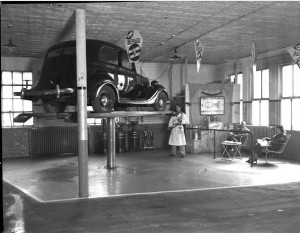 State aid time is just around the corner. But first, let’s talk about this little thing called maintenance of effort (a/k/a MOE). Some of you are aware of this, as you recently received letters explaining it. If you didn’t receive a letter, then you don’t have to worry about it. But for future reference, read on. The MOE requirement applies to libraries who will be receiving state aid, which means that they are accredited and they have submitted an annual public library survey via Bibliostat online. The maintenance of effort requirement is that the “local income support for the library is at least equal to the lowest annual income from the three previous years.” In other words, we look at the local funding (as reported on your public library survey) for the three prior years (in this case 2011, 2012, and 2013) and compare that to the current data that we use for state aid calculations (in this case 2014 data). The most recently submitted public library survey covers the 2015 year, and that data will be used in next year’s calculations. If you did not receive a letter in the mail, then your library met the MOE requirements. For those libraries that didn’t meet the MOE requirement, it’s possible that their state aid will be reduced by the percentage proportionate to the decrease in local funding. Now today’s post is also a quick reminder for those that received MOE letters that the deadline to file a waiver is April 15, 2016. Some of you have already filed waivers or otherwise explained reporting errors, and that data has been adjusted. If the city clerk can verify that the library budget was reduced at the same percentage as that of the rest of the city budget, then that is grounds for a waiver. So, if you are filing a waiver, get it in soon – like by the end of the week. State aid letters indicating what your payment will be will be send out toward the end of April. Photo of the jacked up car awaiting maintenance by the William Masters lookalike is courtesy of Nebraska Memories. Shaka.
State aid time is just around the corner. But first, let’s talk about this little thing called maintenance of effort (a/k/a MOE). Some of you are aware of this, as you recently received letters explaining it. If you didn’t receive a letter, then you don’t have to worry about it. But for future reference, read on. The MOE requirement applies to libraries who will be receiving state aid, which means that they are accredited and they have submitted an annual public library survey via Bibliostat online. The maintenance of effort requirement is that the “local income support for the library is at least equal to the lowest annual income from the three previous years.” In other words, we look at the local funding (as reported on your public library survey) for the three prior years (in this case 2011, 2012, and 2013) and compare that to the current data that we use for state aid calculations (in this case 2014 data). The most recently submitted public library survey covers the 2015 year, and that data will be used in next year’s calculations. If you did not receive a letter in the mail, then your library met the MOE requirements. For those libraries that didn’t meet the MOE requirement, it’s possible that their state aid will be reduced by the percentage proportionate to the decrease in local funding. Now today’s post is also a quick reminder for those that received MOE letters that the deadline to file a waiver is April 15, 2016. Some of you have already filed waivers or otherwise explained reporting errors, and that data has been adjusted. If the city clerk can verify that the library budget was reduced at the same percentage as that of the rest of the city budget, then that is grounds for a waiver. So, if you are filing a waiver, get it in soon – like by the end of the week. State aid letters indicating what your payment will be will be send out toward the end of April. Photo of the jacked up car awaiting maintenance by the William Masters lookalike is courtesy of Nebraska Memories. Shaka.
Posted in General, Library Management, Uncategorized
Leave a comment
The Data Dude on Makerspace Survey (pt. 2)
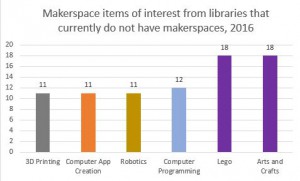 Last week, we took a brief look at some of the survey data from a recent (2016) NLC survey on makerspaces (part 1). Specifically, we looked at the most common items that are available in existing Nebraska library makerspaces. Today, we will look at those libraries that expressed interest in having a makerspace in their library, but do not currently have a space. Many of these libraries are in the planning stages. There are a few similarities and a few differences with the items already in Nebraska library makerspaces and those that have only thus far expressed interest. Namely, at the top of both lists are arts and crafts items and Legos. Hands down, these are the most common. In fact, 4 out of the 37 respondents who reported having an existing space call the space Lego something or other. This makes a lot of sense, as Legos and arts and craft items are low cost, simple items to have and might not require a great deal of physical space. The differences, however, lie in the fact that among survey respondents who have existing makerspaces, the top items lack a great deal of technology (it should be noted that 3D printers were at least prevalent enough to make the chart). Conversely, among those interested or planning spaces, technology related items (computer app creation, computer programming, and robotics) were noted as higher, in addition to 3D printers.
Last week, we took a brief look at some of the survey data from a recent (2016) NLC survey on makerspaces (part 1). Specifically, we looked at the most common items that are available in existing Nebraska library makerspaces. Today, we will look at those libraries that expressed interest in having a makerspace in their library, but do not currently have a space. Many of these libraries are in the planning stages. There are a few similarities and a few differences with the items already in Nebraska library makerspaces and those that have only thus far expressed interest. Namely, at the top of both lists are arts and crafts items and Legos. Hands down, these are the most common. In fact, 4 out of the 37 respondents who reported having an existing space call the space Lego something or other. This makes a lot of sense, as Legos and arts and craft items are low cost, simple items to have and might not require a great deal of physical space. The differences, however, lie in the fact that among survey respondents who have existing makerspaces, the top items lack a great deal of technology (it should be noted that 3D printers were at least prevalent enough to make the chart). Conversely, among those interested or planning spaces, technology related items (computer app creation, computer programming, and robotics) were noted as higher, in addition to 3D printers.
Finally, a couple of maker plugs. The Three Rivers Library System is sponsoring a makerspace workshop with NLC Technology and Innovation librarian, Craig Lefteroff next week on April 12, 2016. Secondly, the upcoming April 27, 2016 NCompass Live, titled Lessons Learned Establishing a Technology Makerspace – Online may be of interest. Shaka.
Posted in General, Library Management, Programming, Technology, Uncategorized
Leave a comment
The Data Dude on the Makerspace Survey (pt. 1)
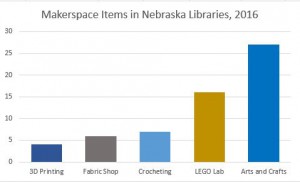 Earlier this year, we launched a survey to gather data on library makerspaces. Today’s post, and this might have the capability to be milked, er, I mean stretched out — over the course of a few weeks, will provide a brief overview of the data collected. First off, there were 150 responses, which is splendid news. A number of the surveys were completed in the first few days after launch. Out of those 150 respondents, only 37 reported currently having a makerspace of some sort in their library (25%), and of that 37, only 14 reported having a permanent space set aside specifically for these activities (9%). The remaining 23 have spaces that are temporary (e.g. they function as meeting or conference rooms but sometimes have makerspace programs, presumably storing the equipment and supplies between events). Today, we will provide a brief synopsis of some of the items in those existing spaces, as illustrated by the bar chart at the right. Specifically, Legos and arts and crafts items make up more than 70% of all items in the spaces. That is a rather large percentage, and goes to show that you can do meaningful or relevant things on the cheap. When we think of big ticket items, we generally think about things like CNC routers, 3D printers, laser cutters, and other techy things; arts and crafts don’t typically come to mind. The point being that it doesn’t take a huge amount of investment to provide programs, and to reap the benefits of community collaboration.
Earlier this year, we launched a survey to gather data on library makerspaces. Today’s post, and this might have the capability to be milked, er, I mean stretched out — over the course of a few weeks, will provide a brief overview of the data collected. First off, there were 150 responses, which is splendid news. A number of the surveys were completed in the first few days after launch. Out of those 150 respondents, only 37 reported currently having a makerspace of some sort in their library (25%), and of that 37, only 14 reported having a permanent space set aside specifically for these activities (9%). The remaining 23 have spaces that are temporary (e.g. they function as meeting or conference rooms but sometimes have makerspace programs, presumably storing the equipment and supplies between events). Today, we will provide a brief synopsis of some of the items in those existing spaces, as illustrated by the bar chart at the right. Specifically, Legos and arts and crafts items make up more than 70% of all items in the spaces. That is a rather large percentage, and goes to show that you can do meaningful or relevant things on the cheap. When we think of big ticket items, we generally think about things like CNC routers, 3D printers, laser cutters, and other techy things; arts and crafts don’t typically come to mind. The point being that it doesn’t take a huge amount of investment to provide programs, and to reap the benefits of community collaboration.
The Dude recently read an article entitled “How to Start a Makerspace When You’re Broke”, which might be good reading for you naysayers that report limited or no funds to provide these sorts of activities. For those of you who have limited space, keep in mind that many libraries (as noted above) have dedicated spaces in those dual purpose areas (or temporary) that might function as a meeting room for some of the time, and maker events for the other. Load the stuff on a cart and wheel it in there, then wheel it back. With warm weather around the corner, head outside on nice days. These might be pragmatic solutions to get you in the game. Shaka.
Posted in General, Library Management, Programming, Technology, Uncategorized
Leave a comment
The Data Dude’s Reminder to Check Your Map Marker
 Are you aware that the Library Commission has a number of public library maps available on its website? In addition to a number of other maps, this page includes the basic public library maps (both by population and library system), a map of libraries and legislative districts, and the Pioneer Consortium participating libraries map. Now for today, the Dude asks that you check your library marker on these public library maps to make sure it displays accurate information. The markers have some of the generic information but also links to the library’s website and social media pages. If you have not updated that information via our supplemental survey, your information on the map may not be up to date. So today is a short little reminder to check those things and let the Dude know if you notice any errors, or log in to your supplemental survey and review the information there. Shaka.
Are you aware that the Library Commission has a number of public library maps available on its website? In addition to a number of other maps, this page includes the basic public library maps (both by population and library system), a map of libraries and legislative districts, and the Pioneer Consortium participating libraries map. Now for today, the Dude asks that you check your library marker on these public library maps to make sure it displays accurate information. The markers have some of the generic information but also links to the library’s website and social media pages. If you have not updated that information via our supplemental survey, your information on the map may not be up to date. So today is a short little reminder to check those things and let the Dude know if you notice any errors, or log in to your supplemental survey and review the information there. Shaka.
Posted in General, Library Management, Uncategorized
Leave a comment
The Data Dude on the Human Library
 In order to meet the constraints of posting something at least weekly, sometimes these things need to venture out into the non-data world. Today is one of those days. Recently, the Dude was reading some news articles about human library projects. What a great idea for a library program. For those of you who might be unfamiliar with such an idea, as far as the Dude can tell, it originated as “Menneskebiblioteket”, the Danish word for Human Library, in Copenhagen in 2000. The idea is pretty simple. The “library” consists of various “books”, which aren’t books at all, but rather just different types of people, or people that have had different experiences and who are willing to share those experiences or knowledge with someone else. Some of these different people who are mentioned on the Human Library website include: naturist (no, that’s not naturalist, but maybe there’s one of those too), young single mother, solider (PTSD), Autism (ASD), Bipolar, Muslim, Unemployed, Refugee, and Homeless). Now if you are interested in such a program, you needn’t invest a lot of cash into purchasing or (in the spirit of the eBook model) leasing these “books”. Rather, it might be a fairly safe bet to say that these people already exist in your community. What a great program for kids. Perhaps you have WWII, Vietnam, or other veterans in your community? Check them out for an hour. Maybe the library could dedicate a space where the checker outer would have to buy the “book” a lunch or something. Make it worth their while. Although the Dude guesses that most of the “books” would definitely do this for free. It may take some coercion, though, as many of these people most likely have a degree of modesty (except for the guy who boasts that he was a big wave surfer, before he injured his knee of course). The most obvious byproduct of this is the connection that forms between the checker outer and the human book. Ideas are exchanged. Lives may be changed. The library is the facilitator. While perhaps listening to someone publically speak about their experiences may certainly be transformative, this type of a program is interactive because it’s a one on one conversation. And, let’s not fail to mention that you may be able to drum up more interest among those wanting to be “books” because they only have to do the one on one (no large crowds). Finally, the library involvement in this is merely the middle man, or the space provider, so let’s call it a low investment program. Shaka.
In order to meet the constraints of posting something at least weekly, sometimes these things need to venture out into the non-data world. Today is one of those days. Recently, the Dude was reading some news articles about human library projects. What a great idea for a library program. For those of you who might be unfamiliar with such an idea, as far as the Dude can tell, it originated as “Menneskebiblioteket”, the Danish word for Human Library, in Copenhagen in 2000. The idea is pretty simple. The “library” consists of various “books”, which aren’t books at all, but rather just different types of people, or people that have had different experiences and who are willing to share those experiences or knowledge with someone else. Some of these different people who are mentioned on the Human Library website include: naturist (no, that’s not naturalist, but maybe there’s one of those too), young single mother, solider (PTSD), Autism (ASD), Bipolar, Muslim, Unemployed, Refugee, and Homeless). Now if you are interested in such a program, you needn’t invest a lot of cash into purchasing or (in the spirit of the eBook model) leasing these “books”. Rather, it might be a fairly safe bet to say that these people already exist in your community. What a great program for kids. Perhaps you have WWII, Vietnam, or other veterans in your community? Check them out for an hour. Maybe the library could dedicate a space where the checker outer would have to buy the “book” a lunch or something. Make it worth their while. Although the Dude guesses that most of the “books” would definitely do this for free. It may take some coercion, though, as many of these people most likely have a degree of modesty (except for the guy who boasts that he was a big wave surfer, before he injured his knee of course). The most obvious byproduct of this is the connection that forms between the checker outer and the human book. Ideas are exchanged. Lives may be changed. The library is the facilitator. While perhaps listening to someone publically speak about their experiences may certainly be transformative, this type of a program is interactive because it’s a one on one conversation. And, let’s not fail to mention that you may be able to drum up more interest among those wanting to be “books” because they only have to do the one on one (no large crowds). Finally, the library involvement in this is merely the middle man, or the space provider, so let’s call it a low investment program. Shaka.
P.S. – The Criss Library at UNO is sponsoring a human library event on April 13, 2016
Posted in General, Library Management, Programming, Uncategorized
Leave a comment
Friday Reads: Carsick by John Waters
“It wasn’t until I started reading and found books they wouldn’t let us read in school that I discovered you could be insane and happy and have a good life without being like everybody else.”
― John Waters
Let’s just say right off the top, if you’ve already heard of John Waters and have seen and didn’t care for his movies, you probably will not like this book. If you weren’t offended by his films (Ok, if you might have been just a bit moderately offended but not totally disgusted to the point that you could no longer watch), this book could be right up your alley. For me, it certainly was! I loved it, laughing harder than I have in months. Maybe even years! Crammed full of carnival oddities, raw direct adult language, filth (both general and specific), the grotesque, and other assorted deviances, this book is definitely not for the squeamish. Consisting of various explicit stories told in the most humorous of fashions, the basic premise is that Waters (often called the Pope of Trash or the People’s Pervert) hitchhikes from his home in Baltimore to his second home in San Francisco and then details his experience on the road. The first two parts of the book are fiction and are told in a fashion very Waters-esque, living up to his aforementioned unofficial titles. Part one is a chronicle of what his journey across the country would be like from a best case scenario perspective; part two from a worst case perspective. The final third of the book details what actually happened in his hitchhike across the country. We salute and thank you, John Waters (and my local library for including this book in the collection), for feeding the soul of the low brow reader.
The Data Dude – NLC Supplemental Survey
 Today’s post is a friendly reminder to complete your NLC supplemental survey. If you have not completed yours, log in to the supplemental survey and knock it out. It won’t take much time. The supplemental survey provides information used in online web pages, public library maps, and other directories. The survey asks questions about public library staff, board members, friends groups, hours, website URL’s, and library social media accounts. It is important to keep this information up to date. The survey can be completed at any time the library information changes, but reminders are sent around the time of the annual public library survey (that’d be now). The ID and password for the supplemental survey are the same as your Bibliostat ID and password. If you don’t remember yours, contact me and I will send it to you. Shaka.
Today’s post is a friendly reminder to complete your NLC supplemental survey. If you have not completed yours, log in to the supplemental survey and knock it out. It won’t take much time. The supplemental survey provides information used in online web pages, public library maps, and other directories. The survey asks questions about public library staff, board members, friends groups, hours, website URL’s, and library social media accounts. It is important to keep this information up to date. The survey can be completed at any time the library information changes, but reminders are sent around the time of the annual public library survey (that’d be now). The ID and password for the supplemental survey are the same as your Bibliostat ID and password. If you don’t remember yours, contact me and I will send it to you. Shaka.
Posted in General, Library Management, Uncategorized
Leave a comment
The Data Dude – Wednesday Watch: Nurse Jackie
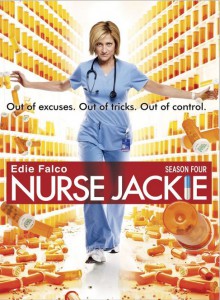 Emotionally, watching Nurse Jackie gives you a taste of what actually living with or having some sort of relationship (e.g. romantic, ex-spouse, work) with an addict might feel like. Albeit the Nurse Jackie TV experience may not be quite as dramatic as living it in real life, certainly the TV Nurse Jackie gets a lot of the typical behaviors of an addict right. And, let’s face the truth, it ain’t pretty. Nurse Jackie, played splendidly by Edie Falco, is a NYC nurse in an ER trauma center. At first, we feel empathy for Jackie because she is a really good nurse. She cuts through red tape to make things happen, is responsive to her patients, saves lives, gets things done when they need to be done, and has a good bedside manner. Rather quickly, however, we discover the sketchy moral ground Jackie walks on, and while we still feel some degree of empathy when it comes to her work relationships (e.g. between Jackie and the ER patients), in the other areas of her life things start to slowly erode. Yet still, as these things diminish, the affinity the Dude felt for those other people in Jackie’s life increased. In addition to Jackie’s sketchy interpretation of the code of nursing ethics, she often makes questionable life choices when it comes to the other areas of her life. Jackie’s drug of choice is prescription medication (mostly painkillers).
Emotionally, watching Nurse Jackie gives you a taste of what actually living with or having some sort of relationship (e.g. romantic, ex-spouse, work) with an addict might feel like. Albeit the Nurse Jackie TV experience may not be quite as dramatic as living it in real life, certainly the TV Nurse Jackie gets a lot of the typical behaviors of an addict right. And, let’s face the truth, it ain’t pretty. Nurse Jackie, played splendidly by Edie Falco, is a NYC nurse in an ER trauma center. At first, we feel empathy for Jackie because she is a really good nurse. She cuts through red tape to make things happen, is responsive to her patients, saves lives, gets things done when they need to be done, and has a good bedside manner. Rather quickly, however, we discover the sketchy moral ground Jackie walks on, and while we still feel some degree of empathy when it comes to her work relationships (e.g. between Jackie and the ER patients), in the other areas of her life things start to slowly erode. Yet still, as these things diminish, the affinity the Dude felt for those other people in Jackie’s life increased. In addition to Jackie’s sketchy interpretation of the code of nursing ethics, she often makes questionable life choices when it comes to the other areas of her life. Jackie’s drug of choice is prescription medication (mostly painkillers).
Just like real life, there is much comedy surrounding the tragedy, and this is mostly due to a strong cast of supporting characters. Notably, these include nurse Zoey (Merritt Wever), pharmacist Eddie (Paul Schulze), best friend of Jackie Dr. O’Hara (Eve Best), Dr. Cooper (Peter Facinelli), hospital administrator Gloria Akalitus (Anna Deavere Smith), and nurse colleague Thor (Stephen Wallem). The comedy is not always under the blanket of Jackie’s addiction, but rather the recurring oddball characters, strange ER situations, and typical daily life situations. And because this is Showtime, it probably lends itself to a bit more believability, as the normal network constraints are absent. Many times in the past, we’ve seen male lead characters unravel in front of us, often predictably so as they sink down a moral mudslide (e.g. Walter White, Don Draper, Dexter Morgan, Ray Donovan, Hank Moody, and Frank Underwood to name a few), but in rarer times do we see this in female leads. Arguably, Nancy Botwin (Weeds) and Carrie Mathison (Homeland), might fit the ticket, but that also might be a bit of a stretch. There is a parallel here (with the unraveling bit), and as Jackie wavers here and there she undoubtedly is headed down that same path.
According to FirstSearch and depending on the season, only 4 Nebraska public libraries have Nurse Jackie in their collection. If your library is looking for something that is half drama half comedy, Nurse Jackie would fit the bill. Thank you, Showtime, for permissions on the cover art. Shaka.
Posted in General, Library Management, Uncategorized
Leave a comment
The Data Dude on Post-Public Library Survey
 Now that the deadline for the public library survey has passed, perhaps it might be beneficial to reiterate the importance of collecting this data. If, as you were collecting and reporting this data, you might have been thinking that this is all a complete waste of time, today the Dude will attempt to illustrate that not all of your work was done in vain. And please, while thoughts are fresh in your head, feel free to e-mail suggestions about how things might be better for next year’s survey. Are there questions that are no longer relevant in your opinion? Questions that were ambiguous? Edit checks that didn’t make sense (admittedly, the Dude got tired of looking at “we did not loan any items to other libraries”)? No suggestion is too trivial for consideration!
Now that the deadline for the public library survey has passed, perhaps it might be beneficial to reiterate the importance of collecting this data. If, as you were collecting and reporting this data, you might have been thinking that this is all a complete waste of time, today the Dude will attempt to illustrate that not all of your work was done in vain. And please, while thoughts are fresh in your head, feel free to e-mail suggestions about how things might be better for next year’s survey. Are there questions that are no longer relevant in your opinion? Questions that were ambiguous? Edit checks that didn’t make sense (admittedly, the Dude got tired of looking at “we did not loan any items to other libraries”)? No suggestion is too trivial for consideration!
As many of you know, the public library survey is a requirement for your library if you are accredited, and if you aren’t accredited, there is candy dangled in front of you in the form of 200 bucks if you complete the survey. This program is called Dollar$ for Data. Now aside from these perceived bribes and threats to complete the survey, what are some of the other reasons for doing it? There certainly are some, aren’t there? Well, let’s first mention some of the national reasons, as every state (and U.S. territory) must collect and submit public library survey data to the Institute of Museum and Library Services (a/k/a IMLS). IMLS, in case you didn’t know, is an independent agency created by the U.S. federal government, and is responsible for the primary support of the libraries and museums in the nation (and U.S. territories). This involves many things such as the formulation of policies, research, and collaboration with state library administrative agencies (such as the Library Commission). But part of all this is that IMLS also distributes funding and grants to libraries and museums. Data collection and analysis is a part of the development and continuation of those federal programs.
At the state and local level, collecting this data is important for those same reasons. An example is that it would be hard to demonstrate funding requests for things like the Nebraska OverDrive consortium without having any data, statistics, or trend files that illustrate the use of electronic materials. What about strategic planning? Many of you might already know that every library in the state has what are called “peer libraries”. These are libraries that are identified as similar to your library. Most of the time this means that they are within a certain range of your legal service area (or LSA). At the local level, this is important because you can then compare things like your collection, staffing, budget, and other library services with your peers (a/k/a keeping up with the Joneses). Some of the peer libraries are Iowa libraries because there aren’t enough comparable libraries in Nebraska.
Finally, if you want data for your peer libraries (and after this year’s survey cycle is over, we will re-calculate your peer libraries – most likely this coming summer, so keep that in mind), you can contact the Dude and he will extract and send (E&S) those data files to you. There is also the IMLS compare public libraries tool, which allows you to pull comparable nationwide data. Keep in mind, however, that the data for the compare tool is usually a year behind the data that many states (including Nebraska) collect and publish. It might, however, be a good starting point to identify similar libraries. Finally, if you are looking for more current data from states other than Nebraska, the Colorado Library Research Service provides a page that has links to the data files for each state, if those are available. Shaka.
Posted in General, Library Management, Uncategorized
Leave a comment
The Data Dude – Public Library Survey
 For you procrastinators, it is now the moment of truth for the annual IMLS Public Library Survey. The deadline is February 19, 2016. The Bibliostat Collect portion of the data services section of the NLC website has a link to the login, instructions, tips, and other tidbits to help you complete the survey. Keep in mind that the survey is required for your library to receive state aid if you are accredited. If you aren’t accredited, you still have an incentive to complete the survey ($200), called Dollar$ for Data.
For you procrastinators, it is now the moment of truth for the annual IMLS Public Library Survey. The deadline is February 19, 2016. The Bibliostat Collect portion of the data services section of the NLC website has a link to the login, instructions, tips, and other tidbits to help you complete the survey. Keep in mind that the survey is required for your library to receive state aid if you are accredited. If you aren’t accredited, you still have an incentive to complete the survey ($200), called Dollar$ for Data.
If you run into a bind and have special circumstances, please let me know. I am here to help you with the process in any way I can. Don’t hesitate to contact me. Thank you in advance for your participation and patience. Shaka
Posted in General, Library Management, Uncategorized
Leave a comment

